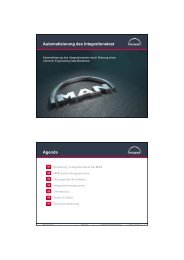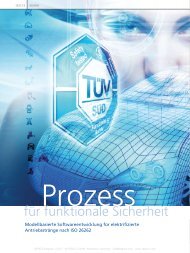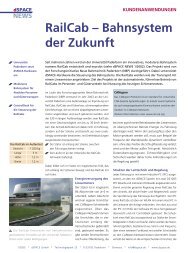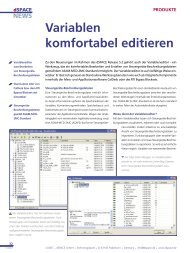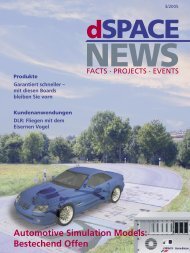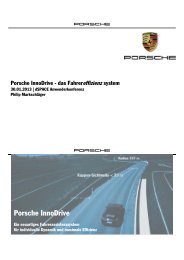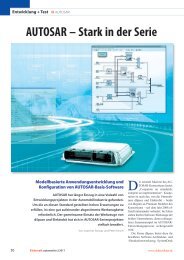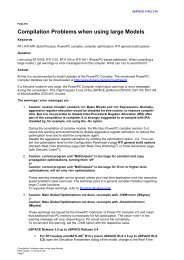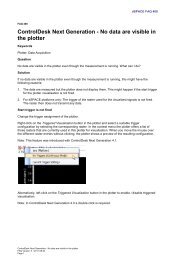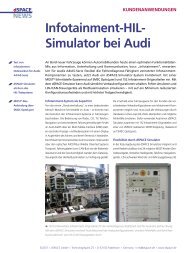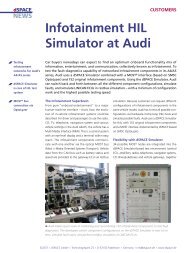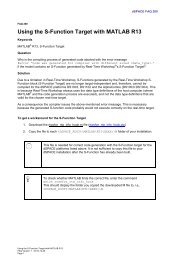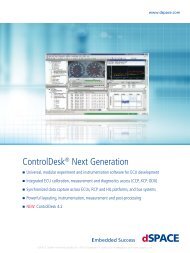magazinE - dSPACE
magazinE - dSPACE
magazinE - dSPACE
You also want an ePaper? Increase the reach of your titles
YUMPU automatically turns print PDFs into web optimized ePapers that Google loves.
pAGe 22 AIR-FUeL RATIO<br />
Fuel supply<br />
Air supply<br />
ETAS Lambda Meter<br />
with Bosch LSA 4.2<br />
UEGO sensor<br />
Borghi & Saveri<br />
E-200S Eddy Current<br />
Dynanometer<br />
Experimental setup with the controller:<br />
The control strategy is made up of two RNNs, describing inverse (IRNNM) and forward (FRNNM) dynamics.<br />
control and external input variables<br />
are: AFR, injection time, engine<br />
speed, and manifold pressure. The<br />
output feedbacks are simulated by<br />
the network itself, so the FRNNM<br />
does not require any AFR measurement<br />
to perform the online estimation.<br />
This makes the controller a suitable<br />
solution for AFR virtual sensing<br />
when the lambda sensor does not<br />
guarantee an accurate measurement,<br />
which happens during cold start<br />
phases. It also allows the delay due<br />
to engine cycle, transport phenomena<br />
and sensor response to be removed.<br />
neural controller<br />
The control actions are computed by<br />
an inverse RNN model (IRNNM) as a<br />
function of sensor measurements of<br />
engine states and external inputs.<br />
The output values predicted by the<br />
FRNNM are fed as feedbacks to the<br />
IRNNM which evaluates the control<br />
AFR [yˆ (t+1)]<br />
Injection time<br />
IRNNM FRNNM<br />
Injection time<br />
Engine<br />
speed<br />
Fuel injection valves<br />
4 cylinder engine, 1.2 I, multi-point injection<br />
AFR<br />
[yˆ (t+1)]<br />
AVL PUMA Open<br />
for testbed<br />
automation<br />
Throttle<br />
opening<br />
NI data<br />
acquisition<br />
system<br />
actions as a function of the desired<br />
output at the next time step. The<br />
more accurate the FRNNM prediction,<br />
the less the difference between the<br />
FRNNM and plant outputs.<br />
Experimental Setup<br />
The developed control strategy was<br />
trained and tested vs. transient data<br />
sets measured on an engine test<br />
bench. The lambda sensor was<br />
placed right after the exhaust valve<br />
of the first cylinder to investigate the<br />
airfuel mixing process in one cylinder<br />
only. This choice allows the dynamic<br />
effects induced by gas transport and<br />
mixing phenomena occurring in the<br />
exhaust pipes to be removed. Nonpredictable<br />
effects generated by<br />
cylindertocylinder unbalance due to<br />
uneven processes such as air breathing,<br />
thermal state and fuel injection<br />
can also be neglected. Therefore, the<br />
time shift between the injection tim<br />
Engine speed<br />
Manifold pressure<br />
Catalyst<br />
AVL Continuous<br />
Fuel Balance<br />
Exhaust<br />
ing and the lambda sensor measurement<br />
mostly accounts for the intake<br />
and exhaust valve phasing. As mentioned<br />
before, the time delay could<br />
be a significant problem for control<br />
applications.<br />
For the realtime application the controller<br />
was modeled with MATLAB ® /<br />
Simulink ® and then uploaded to a<br />
<strong>dSPACE</strong> MicroAutoBox. This compact<br />
prototyping system lets all engine<br />
tasks be controlled directly and<br />
customized variants of the controller<br />
be performed immediately. The direct<br />
controller is intended to provide the<br />
actual injection time by processing<br />
actual and earlier measurements of<br />
the engine speed and manifold<br />
pressure, and the earlier prediction of<br />
AFR performed by the FRNMM.<br />
Furthermore, the target AFR was<br />
imposed and was set to the stoichiometric<br />
value (i. e. 14,67) for the current<br />
application. Due to the lambda



